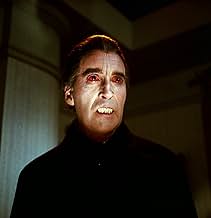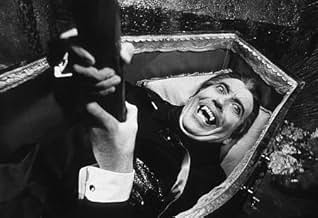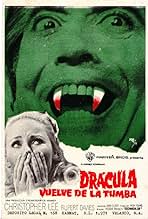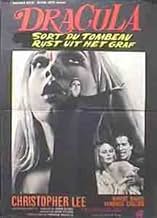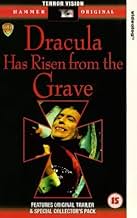IMDb RATING
6.5/10
8.7K
YOUR RATING
After a Monsignor accidentally brings Count Dracula back from the dead while exorcising his castle, the vampire preys on the holy man's beautiful niece and her friends.After a Monsignor accidentally brings Count Dracula back from the dead while exorcising his castle, the vampire preys on the holy man's beautiful niece and her friends.After a Monsignor accidentally brings Count Dracula back from the dead while exorcising his castle, the vampire preys on the holy man's beautiful niece and her friends.
- Director
- Writers
- Stars
- Awards
- 1 nomination total
Christopher Cunningham
- Farmer
- (as Chris Cunningham)
Carrie Baker
- First victim
- (uncredited)
Donald Campbell
- Tavern Customer
- (uncredited)
Frank Forsyth
- Villager
- (uncredited)
Lindsay Hooper
- Tavern Customer
- (uncredited)
Philip Stewart
- Tavern Customer
- (uncredited)
John Timberlake
- Tavern Customer
- (uncredited)
- Director
- Writers
- All cast & crew
- Production, box office & more at IMDbPro
Featured reviews
The folks at Hammer Film Productions were nothing if not passionate and professional. This entry into the legendary series is only an itty-bitty notch below their inaugural effort, the great "Horror Of Dracula,' as the second best of the entire series.
Chrisopher Lee is at his menacing best. No one can drive a horse-pulled hearse with his fierce intensity. And those eyes, YIKES! What a great effect, one that still gets me 35 years after i first saw the film as a 14-year old in Los Angeles' San Gabriel Valley (and where I saw it on TV not 15 minutes ago).
Hammer vets Freddie Francis and Anthony Hinds create killer-diller fun with strong atmosphere; eerie, colorful lighting and a solid story. And the acting is great, too. Hammer staff composer James Bernard's exciting score adds to the enjoyment.
Hammer's films are for kids ... kids like me who loved then as a teenager and kids like me who are now over 50.
Chrisopher Lee is at his menacing best. No one can drive a horse-pulled hearse with his fierce intensity. And those eyes, YIKES! What a great effect, one that still gets me 35 years after i first saw the film as a 14-year old in Los Angeles' San Gabriel Valley (and where I saw it on TV not 15 minutes ago).
Hammer vets Freddie Francis and Anthony Hinds create killer-diller fun with strong atmosphere; eerie, colorful lighting and a solid story. And the acting is great, too. Hammer staff composer James Bernard's exciting score adds to the enjoyment.
Hammer's films are for kids ... kids like me who loved then as a teenager and kids like me who are now over 50.
When his castle is exorcised, Dracula (Christopher Lee) plots his revenge against the Monsignor (Rupert Davies) who performed the rites by attempting to make the holy man's young niece his bride.
This film is scandalous. Sure it passed the censors, and that is great, and Lee gives another great Dracula performance (with Davies as a more than adequate nemesis). But what we have here is an atheist in the home of a clergyman! Can you be an atheist and still believe in vampires?
Apparently, this was the most commercially successful of the Hammer Dracula films. I am not surprised, as it is quite entertaining. And with all due respect to Terence Fisher, I think I tend to prefer Freddie Francis' direction a little more. Francis knows his camera, and I think that adds something to his directing prowess.
This film is scandalous. Sure it passed the censors, and that is great, and Lee gives another great Dracula performance (with Davies as a more than adequate nemesis). But what we have here is an atheist in the home of a clergyman! Can you be an atheist and still believe in vampires?
Apparently, this was the most commercially successful of the Hammer Dracula films. I am not surprised, as it is quite entertaining. And with all due respect to Terence Fisher, I think I tend to prefer Freddie Francis' direction a little more. Francis knows his camera, and I think that adds something to his directing prowess.
If a quintessential example of a Hammer Studio's exercise in Gothic Horror exists, it is probably this film. Not because it is a flawless piece of film-making, far from it. Rather because this film manages to squeeze just about all of Hammer's horror-show templates into it's 92 minute running time.
Here we have the unmistakeably distinctive set design and music score by Hammer mainstays Benard Robinson and James Benard; romantic leads transposing post Summer-of-Love sexual mores (and hairstyles!) to the film's indeterminate post Victorian location; two pub locales, one peopled with wary, hostile, superstitious East-Ender types, the other rollicking with high-spirited youthful inebriates; a pious religious figure (and a much less pious one); a cameo by Michael Ripper; day-for-night location shots; attractive women in low-cut bodices and nightgowns; yet another outlandish method of using trickling blood to revive the antagonist; an eventful screenplay that doesn't measure up to critical evaluation --- whew! I could go on and on.
But please understand, I do not necessarily regard all of the above negatively, just realistically. "D.H.R.F.T.G." is a fun watch if you leave your thinking cap off. Several of the most memorable set-pieces in the Hammer canon are here; the discovery of the girl in the belfry, the attempted staking of Dracula, the Count's seduction of Veronica Carlson, and his over-the-top demise (I won't reveal it here). These scenes lingered for decades in my mind after I saw the film in the early seventies. I was joyful to find the videotape in the '90's and yes, I now happily own the DVD.
One of the harshest critics of this film, incidentally, was it's star. Christopher Lee, who entered the project enduring serious back pain (stuntman Eddie Powell handled the more strenuous action), disliked the script intensely, especially the attempted staking of the Count. His performance, however, betrays none of his vexation; this is one of his best outings as Dracula. Director Freddie Francis coaxes serviceable performances from the rest of the cast. Rupert Davies and Barbara Ewing stand out, as a noble cleric and lusty barmaid respectively.
At the end of the day, I really like this movie, despite it's shortcomings. Heck, I feel like putting on right now. So should you.
Here we have the unmistakeably distinctive set design and music score by Hammer mainstays Benard Robinson and James Benard; romantic leads transposing post Summer-of-Love sexual mores (and hairstyles!) to the film's indeterminate post Victorian location; two pub locales, one peopled with wary, hostile, superstitious East-Ender types, the other rollicking with high-spirited youthful inebriates; a pious religious figure (and a much less pious one); a cameo by Michael Ripper; day-for-night location shots; attractive women in low-cut bodices and nightgowns; yet another outlandish method of using trickling blood to revive the antagonist; an eventful screenplay that doesn't measure up to critical evaluation --- whew! I could go on and on.
But please understand, I do not necessarily regard all of the above negatively, just realistically. "D.H.R.F.T.G." is a fun watch if you leave your thinking cap off. Several of the most memorable set-pieces in the Hammer canon are here; the discovery of the girl in the belfry, the attempted staking of Dracula, the Count's seduction of Veronica Carlson, and his over-the-top demise (I won't reveal it here). These scenes lingered for decades in my mind after I saw the film in the early seventies. I was joyful to find the videotape in the '90's and yes, I now happily own the DVD.
One of the harshest critics of this film, incidentally, was it's star. Christopher Lee, who entered the project enduring serious back pain (stuntman Eddie Powell handled the more strenuous action), disliked the script intensely, especially the attempted staking of the Count. His performance, however, betrays none of his vexation; this is one of his best outings as Dracula. Director Freddie Francis coaxes serviceable performances from the rest of the cast. Rupert Davies and Barbara Ewing stand out, as a noble cleric and lusty barmaid respectively.
At the end of the day, I really like this movie, despite it's shortcomings. Heck, I feel like putting on right now. So should you.
Sporting the ultra camp title - "Dracula Has Risen From the Grave", this is a solid entry in Hammer's Dracula series. What I love about Hammer is that they aren't afraid to take an existing story and play around with it to create something new. Even if the idea behind is less than brilliant and most studios would have shied away, Hammer approach it with gusto, and the results are always good natured, easy viewing that's hard to dislike. This film follows Count Dracula as he is resurrected shortly after the priest, Ernst Muller, exorcises his castle. Dracula doesn't take this sort of behaviour lightly, and so decides to take on revenge on the holy man - by taking his niece as his bride!
Dracula is one of the greatest characters ever to be written and portrayed on screen, and it's also one that Christopher Lee has become famous for playing. Unfortunately, Christopher Lee doesn't have a great deal of screen time in this flick; but every moment he is on screen is a highlight and, as usual, he does well with the role and proves that he is the only man other than Bela Lugosi to do it right. Freddie Francis (Dr Terror, The Creeping Flesh) directs this film and succeeds in creating a morbid and fascinating atmosphere that bodes well with the subject material on hand. The film is stylishly shot, and features some of the best use of lighting ever seen in a Hammer film. The camp style that the studio is famous for is here by the bucket load too, and that can only be a good thing. This is hardly Hammer's finest hour, however; the film is relatively slow to start, and the story isn't the most inventive ever to come from the studio - but Hammer fans will enjoy it, and I would have no qualms with recommending this as a decent waste of your time.
Dracula is one of the greatest characters ever to be written and portrayed on screen, and it's also one that Christopher Lee has become famous for playing. Unfortunately, Christopher Lee doesn't have a great deal of screen time in this flick; but every moment he is on screen is a highlight and, as usual, he does well with the role and proves that he is the only man other than Bela Lugosi to do it right. Freddie Francis (Dr Terror, The Creeping Flesh) directs this film and succeeds in creating a morbid and fascinating atmosphere that bodes well with the subject material on hand. The film is stylishly shot, and features some of the best use of lighting ever seen in a Hammer film. The camp style that the studio is famous for is here by the bucket load too, and that can only be a good thing. This is hardly Hammer's finest hour, however; the film is relatively slow to start, and the story isn't the most inventive ever to come from the studio - but Hammer fans will enjoy it, and I would have no qualms with recommending this as a decent waste of your time.
Released in the USA in the Winter of 1969, Hammer's "Dracula has Risen from the Grave" was the fourth entry in the series and the third with Christopher Lee in the title role. Here's a list of the nine films for those interested:
Horror of Dracula (1958); The Brides of Dracula (1960); Dracula: Prince of Darkness (1966); Dracula Has Risen from the Grave (1968); Taste the Blood of Dracula (1969); Scars of Dracula (1970); Dracula AD 1972 (1972); The Satanic Rites of Dracula (1973); and The Legend of the 7 Golden Vampires (1974).
"Dracula has Risen from the Grave" suffers from a weak prologue and first act. The prologue takes place a year prior to the main story. The first act involves two priests hiking up to Dracula's castle to exorcise it. One of the priests unwittingly resurrects the count and the vampire wants revenge on the other priest whom he discovers blessed his abode. The final hour involves Dracula going after his niece in a neighboring village. The niece's boyfriend and the priest must defend her.
Like I said, the whole first act isn't very promising, but things perk up with the introduction of the niece's boyfriend, Paul, and the pub his dad runs. Barbara Ewing plays Zena, the redhead waitress at the pub, and the film shows the close relationships between Paul, his father and Zena. The characters ring true and it draws the viewer into their world. Excellent job on this front.
A great scene takes place when Paul's girlfriend, Maria (played by the stunning Veronica Carlson), takes Paul to her home to introduce him to her mother and the priest, who's a Monsignor (whatever that is). Paul is cornered in a conversation and forced to reveal that he doesn't believe in God. The Monsignor is initially offended and rude, but this can be excused on the grounds that he's the father-figure to his beloved niece; besides there's a warmhearted scene later in the film where the Monsignor proves his loving nature.
Another unusual highlight of the film are the multiple scenes that take place on the labyrinthian rooftops of the Victorian village. I can't help but wonder how they accomplished this. Were they really filming on the rooftops of a village or is it an illusion accomplished through matte paintings or other effects? I'm sure it's the latter; regardless, it's excellent film work and a unique feature of this film.
Of course, Hammer films are renown for their curvaceous women and here we have two: Redhead Barbara Ewing as the very likable Zena, and Veronica Carlson, who can also be seen in the outstanding "Frankenstein Must Be Destroyed".
As with most of Hammer's horror flicks, the movie possesses a beautifully lush, Gothic atmosphere.
Despite the weak first act, the positives noted above compel me place "Dracula has Risen from the Grave" as my second or third favorite of the series. My favorite being "Taste the Blood of Dracula."
The film runs 92 minutes and was shot at Pinewood Studios, Buckinghamshire, England.
GRADE: B
Horror of Dracula (1958); The Brides of Dracula (1960); Dracula: Prince of Darkness (1966); Dracula Has Risen from the Grave (1968); Taste the Blood of Dracula (1969); Scars of Dracula (1970); Dracula AD 1972 (1972); The Satanic Rites of Dracula (1973); and The Legend of the 7 Golden Vampires (1974).
"Dracula has Risen from the Grave" suffers from a weak prologue and first act. The prologue takes place a year prior to the main story. The first act involves two priests hiking up to Dracula's castle to exorcise it. One of the priests unwittingly resurrects the count and the vampire wants revenge on the other priest whom he discovers blessed his abode. The final hour involves Dracula going after his niece in a neighboring village. The niece's boyfriend and the priest must defend her.
Like I said, the whole first act isn't very promising, but things perk up with the introduction of the niece's boyfriend, Paul, and the pub his dad runs. Barbara Ewing plays Zena, the redhead waitress at the pub, and the film shows the close relationships between Paul, his father and Zena. The characters ring true and it draws the viewer into their world. Excellent job on this front.
A great scene takes place when Paul's girlfriend, Maria (played by the stunning Veronica Carlson), takes Paul to her home to introduce him to her mother and the priest, who's a Monsignor (whatever that is). Paul is cornered in a conversation and forced to reveal that he doesn't believe in God. The Monsignor is initially offended and rude, but this can be excused on the grounds that he's the father-figure to his beloved niece; besides there's a warmhearted scene later in the film where the Monsignor proves his loving nature.
Another unusual highlight of the film are the multiple scenes that take place on the labyrinthian rooftops of the Victorian village. I can't help but wonder how they accomplished this. Were they really filming on the rooftops of a village or is it an illusion accomplished through matte paintings or other effects? I'm sure it's the latter; regardless, it's excellent film work and a unique feature of this film.
Of course, Hammer films are renown for their curvaceous women and here we have two: Redhead Barbara Ewing as the very likable Zena, and Veronica Carlson, who can also be seen in the outstanding "Frankenstein Must Be Destroyed".
As with most of Hammer's horror flicks, the movie possesses a beautifully lush, Gothic atmosphere.
Despite the weak first act, the positives noted above compel me place "Dracula has Risen from the Grave" as my second or third favorite of the series. My favorite being "Taste the Blood of Dracula."
The film runs 92 minutes and was shot at Pinewood Studios, Buckinghamshire, England.
GRADE: B
Did you know
- TriviaThis was Hammer Films' most profitable movie.
- GoofsWhen the bell-ringer arrives at the church at the beginning of the movie he leaves his bicycle on the steps of the front door. When the priest arrives and rushes to investigate the screaming, the bicycle is no longer there.
- Alternate versionsThe UK cinema version was cut by the BBFC to remove some closeup shots of Dracula pulling a stake from his heart. Later video and DVD releases were uncut.
- ConnectionsFeatured in Taste the Blood of Dracula (1970)
Details
- Release date
- Country of origin
- Languages
- Also known as
- Drácula vuelve de la tumba
- Filming locations
- Production company
- See more company credits at IMDbPro
- Runtime
- 1h 32m(92 min)
- Sound mix
- Aspect ratio
- 1.66 : 1(original/negative ratio)
Contribute to this page
Suggest an edit or add missing content



